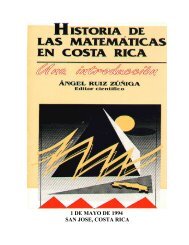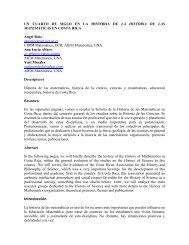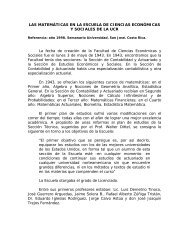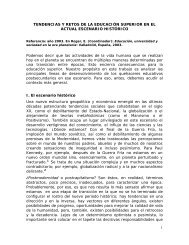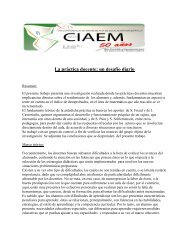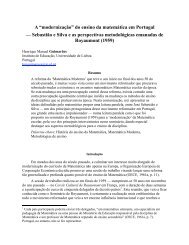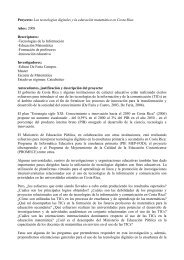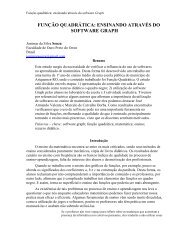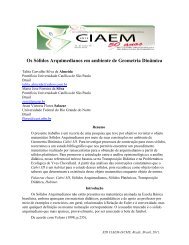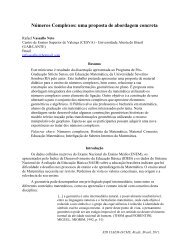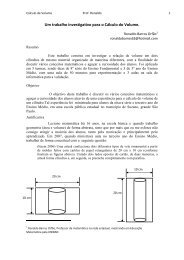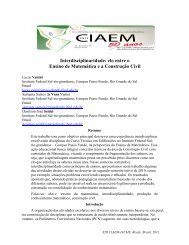Reform of the construction of the number system with ... - CIMM
Reform of the construction of the number system with ... - CIMM
Reform of the construction of the number system with ... - CIMM
You also want an ePaper? Increase the reach of your titles
YUMPU automatically turns print PDFs into web optimized ePapers that Google loves.
34 H. Griesel<br />
3.2 Positive rational <strong>number</strong>s as operators<br />
on quantity domains<br />
The ma<strong>the</strong>matical foundations <strong>of</strong> <strong>the</strong> reform <strong>of</strong> <strong>the</strong><br />
<strong>construction</strong> <strong>of</strong> <strong>the</strong> <strong>number</strong> <strong>system</strong> were researched by<br />
Lugowski (1962), Kirsch (1970), Pickert (1968) and<br />
Griesel (1968, 1971, 1973a, b, 1974). In order to achieve<br />
application-orientation, Lugowski (1962) introduced,<br />
<strong>with</strong>out knowledge <strong>of</strong> Frege’s considerations, <strong>the</strong><br />
concept <strong>of</strong> quantity domain. The definition, going back<br />
to Kirsch, <strong>of</strong> a quantity domain as a linear-ordered,<br />
Abelian semi-group, <strong>with</strong> <strong>the</strong> additional condition<br />
a < b , $c a+ c = b is now used (Kirsch, 1970, p. 43).<br />
This was developed independent <strong>of</strong> Frege’s deliberations<br />
30 years before <strong>the</strong> re<strong>construction</strong> <strong>of</strong> Frege’s<br />
considerations by <strong>the</strong> Neo-Fregeanism. It is remarkable<br />
that <strong>the</strong> concept <strong>of</strong> quantity domain according to<br />
Kirsch agrees <strong>with</strong> <strong>the</strong> concept <strong>of</strong> quantitative domain<br />
according to Frege.<br />
Also Hans Georg Steiner pursued <strong>the</strong>se considerations<br />
<strong>with</strong> interest although he himself has not intervened<br />
actively. After all, a report about this German<br />
development in Educational Studies (Steiner, 1969)<br />
was written by him.<br />
The positive rational <strong>number</strong>s were introduced as<br />
operators on divisible quantity domains (Griesel,<br />
1973a). For instance, <strong>the</strong> <strong>number</strong> ’ became a chain <strong>of</strong><br />
<strong>the</strong> stretcher 3 <strong>with</strong> <strong>the</strong> shrinker :4. That had <strong>the</strong><br />
advantage <strong>of</strong> machanical concretization. The forming<br />
<strong>of</strong> fraction-parts could be regarded as applying an<br />
operator to a value <strong>of</strong> a quantity and multiplication as<br />
connecting fraction operators in series dynamically.<br />
3.3 Problems <strong>with</strong> <strong>the</strong> implementation<br />
<strong>of</strong> <strong>the</strong> curricula<br />
During <strong>the</strong> implementation <strong>of</strong> <strong>the</strong> curricula <strong>the</strong>re were<br />
difficulties in understanding in <strong>the</strong> majority <strong>of</strong> <strong>the</strong> classes.<br />
The embedding <strong>of</strong> <strong>the</strong> natural <strong>number</strong>s into <strong>the</strong> new<br />
rational <strong>number</strong>s was not understood by many students.<br />
That was not surprising since <strong>the</strong> students were acquainted<br />
<strong>with</strong> <strong>the</strong> natural <strong>number</strong>s for 5 years as finite<br />
cardinals. Now <strong>the</strong>se <strong>number</strong>s should abruptly be<br />
operators. Also, <strong>the</strong> proposal <strong>of</strong> Kirsch to interpret <strong>the</strong><br />
natural <strong>number</strong>s in a specific curriculum as operators<br />
before beginning <strong>with</strong> <strong>the</strong> introduction <strong>of</strong> <strong>the</strong> rational<br />
<strong>number</strong>s was not successful (Griesel, 1973a). Therefore,<br />
<strong>the</strong> introduction <strong>of</strong> <strong>the</strong> natural <strong>number</strong>s as operators<br />
was stopped. The authors <strong>of</strong> <strong>the</strong> textbooks returned to a<br />
more conventional introduction. But, <strong>the</strong>y were at least<br />
able to improve <strong>the</strong>ir curricula by some results <strong>of</strong><br />
didactical research like <strong>the</strong> quasi-cardinal aspect <strong>of</strong> <strong>the</strong><br />
positive rational <strong>number</strong>s (see Sect. 3.4).<br />
123<br />
3.4 Basic structure <strong>of</strong> <strong>the</strong> current curricula<br />
for <strong>the</strong> <strong>construction</strong> <strong>of</strong> <strong>the</strong> <strong>number</strong> <strong>system</strong><br />
The current curricula for <strong>the</strong> <strong>construction</strong> <strong>of</strong> <strong>the</strong> <strong>number</strong><br />
<strong>system</strong> in Germany have <strong>the</strong> following basic structure:<br />
From <strong>the</strong> first to fifth school years, <strong>the</strong> natural <strong>number</strong>s<br />
are regarded as finite cardinals, <strong>the</strong>refore, as values <strong>of</strong> a<br />
quantity. Addition and multiplication are also introduced<br />
in connection <strong>with</strong> this quantity. A detachment<br />
from <strong>the</strong> idea <strong>of</strong> finite cardinals, and <strong>the</strong>refore, a treatment<br />
<strong>of</strong> natural <strong>number</strong>s as objects in <strong>the</strong>ir own right<br />
takes place in <strong>the</strong> <strong>the</strong>ory <strong>of</strong> divisibility in <strong>the</strong> fifth school<br />
year <strong>with</strong> <strong>the</strong> concepts divisor, multiple, greatest common<br />
divisor, least common multiple, and prime <strong>number</strong>.<br />
In <strong>the</strong> <strong>the</strong>ory <strong>of</strong> fractions in <strong>the</strong> sixth school year <strong>the</strong><br />
positive rational <strong>number</strong>s are understood as ratios <strong>of</strong> a<br />
part to a whole (in German: Anteile) and <strong>the</strong>refore also<br />
as values <strong>of</strong> a quantity. Besides <strong>the</strong> difficulties, given by<br />
<strong>the</strong> concepts <strong>of</strong> natural <strong>number</strong>s as finite cardinals and<br />
<strong>the</strong> positive rational <strong>number</strong>s as ratios <strong>of</strong> a part to a<br />
whole are reduced by quasi-cardinal considerations<br />
(Griesel, 1981). For instance, a fraction like ’ is in this<br />
case understood as 3 fourths, <strong>the</strong>refore, as a cardinal <strong>of</strong><br />
fourths. But it is not possible to give reason for <strong>the</strong> rule<br />
<strong>of</strong> reducing fractions to lower respective higher terms<br />
by <strong>the</strong> quasi-cardinal aspect except by <strong>the</strong> intuitive<br />
concept <strong>of</strong> ratio <strong>of</strong> a part to a whole.<br />
The picture given by <strong>the</strong> negative <strong>number</strong>s is not so<br />
homogenous. There are several manners and forms <strong>of</strong><br />
<strong>the</strong> negative <strong>number</strong>s in <strong>the</strong> curricula. References are<br />
found in Postel (2005) and Griesel (2003).<br />
There are also no homogenous characteristics <strong>of</strong> <strong>the</strong><br />
operations addition and multiplication that can be<br />
found in all kinds <strong>of</strong> <strong>number</strong>s.<br />
The multiplication <strong>of</strong> natural <strong>number</strong>s is introduced<br />
in close relationship to <strong>the</strong> interpretation <strong>of</strong> <strong>the</strong>se<br />
<strong>number</strong>s as finite cardinals. 3 4, for example means<br />
<strong>the</strong> cardinal <strong>of</strong> a set, which is <strong>the</strong> set-<strong>the</strong>oretical union<br />
<strong>of</strong> three disjoint sets each <strong>with</strong> four elements.<br />
The multiplication <strong>of</strong> positive rational <strong>number</strong>s is<br />
introduced in close relationship to <strong>the</strong> interpretation <strong>of</strong><br />
<strong>the</strong>se <strong>number</strong>s as ratios <strong>of</strong> a part to a whole. 2/3 5/8<br />
for example means that a ratio which is obtained as<br />
follows: One forms 5/8 from a whole and forms 2/3<br />
from that part. The ratio <strong>of</strong> this new part to <strong>the</strong> original<br />
whole is <strong>the</strong>n 2/3 5/8. This is <strong>the</strong> classical interpretation<br />
<strong>of</strong> <strong>the</strong> multiplication as forming portion-from. In<br />
brief: times means from. The rule <strong>of</strong> multiplication <strong>of</strong><br />
fractions (in brief: numerator times numerator,<br />
denominator times denominator) <strong>the</strong>n can be proved.<br />
The introductions <strong>of</strong> multiplication <strong>of</strong> <strong>the</strong> natural<br />
and <strong>the</strong> positive rational <strong>number</strong>s are clearly application-oriented.<br />
The relationship under each o<strong>the</strong>r must




